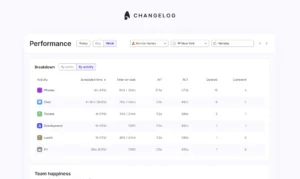
Cut call centre costs with these 6 top tips

If you’re looking to reduce the costs of your business, there’s a good chance you’ve looked at call centres as a potential source of cost savings. With round-the-clock staffing, training, and software, the expenditures can seem to pile up, and your call centre might seem like a great place to start trimming the fat.
Make no mistake though, call centres are an essential part of your organisation. You need to be able to offer support to your customers and provide an outlet for feedback, general queries, and more. Moreover, as one of the primary points of contact for customers, a call centre can act as the face of your business — a negative interaction puts customer loyalty at risk.
But just because you want to offer quality support, it doesn’t mean you need to break the bank. Keep reading this guide for some tips to create call centre cost savings, without sacrificing the quality of your customer support.
1. Optimise key metrics
Making sure you optimise key performance metrics like Average Handle Time (AHT) and First Call Resolution (FCR) is helpful for reducing operational costs. AHT tracks the average time spent on a call, including post-call work, while FCR measures the percentage of calls resolved during the first interaction. Improving these metrics means you can reduce repeat calls, lower the overall volume of interactions, and boost agent productivity. Lowering AHT increases the number of calls each agent can handle, allowing you to manage higher volumes with fewer resources. Similarly, improving FCR means fewer follow-up calls are needed, reducing the workload on agents and decreasing the cost per call. Other call centre efficiency metrics you should consider can be found here.
Implementation tips
- Use CRM systems to give your agents access to all relevant customer information, speeding up resolution times to boost both AHT and FCR. You can further improve this with the addition of AI ‘Copilot’ tools, which highlight key, relevant customer information to the agent during the call.
- Set targets and continuously monitor these metrics and provide real-time feedback to your agents for improvement, allowing you to create a positive feedback loop to improve your team’s performance.
- You can further improve this with the addition of AI ‘Copilot’ tools, which highlight key, relevant customer information to the agent during the call.
2. Adopt flexible staffing models
Not all time periods will create the same demand for customer support. Flexible staffing involves employing part-time, temporary, or seasonal workers to manage peak periods, reducing the need for full-time staff year-round. This approach supports the shift towards more flexible work arrangements that have gained momentum post-pandemic.
By scaling your workforce based on demand, you avoid the costs associated with maintaining a fully staffed team during slow periods. Additionally, flexible staffing can improve employee satisfaction, as it caters to modern work preferences of a hybrid work environment, which helps reduce turnover and its associated costs.
Implementation tips
- Use workforce management software, like Surfboard, to forecast peak periods using historical data. This helps you meet staffing with actual needs, reducing unnecessary labour costs.
- During peak times, consider employing temporary workers or offering flexible work schedules to part-time staff. This approach both reduces costs and enhances agent retention by providing them a flexible option.
- Implementing models such as annualised hours can also enable you to scale full time employee’s hours up or down across the year to match demand, while also providing additional flexibility for agents.
3. Use workforce management software
Workforce Management (WFM) software is a one-stop solution which is designed to increase the efficiency of your call centre operations. WFM software helps with forecasting call volumes, scheduling, managing agent performance, tracking adherence, and allocating resources. By automating these processes, WFM software ensures that your call centre is staffed appropriately, agents are utilised efficiently, and customer service quality is consistently high. WFM software can automatically adjust staffing levels with demand, preventing both overstaffing, which increases costs, and understaffing, which can result in poor service and expensive overtime. Additionally, it streamlines administrative tasks, freeing up management to focus on more important activities. Read about how Surfboard can reduce call centre costs and improve your customer support here.
Implementation tips
- Select a WFM tool which integrates with your existing systems and offers powerful features like forecasting, scheduling, adherence tracking, and real-time analytics. Check out Surfboard’s capabilities and learn about the ways an advanced WFM software can set your call centre up for success.
- Implement the software and provide training for your team, to empower them get the most out of your chosen software.
- Continuously monitor performance metrics and adjust staffing and processes based on real-time data provided by the WFM solution.
4. Invest in training and development
Your call centre team can only be as strong as its individual agents. A well-trained team is important for maintaining efficiency, reducing turnover, and boosting productivity. While it might seem like a significant investment, continuous training and development not only improves agent skills but also increases retention and reduces costs associated with recruiting and onboarding new employees. In the long run, investments in training will create call centre cost reductions.
Since customer impressions are often shaped by interactions with support agents, especially in businesses operating primarily online, the importance of end-to-end call centre training cannot be overstated. Effective training programs contribute to both the agent experience and the customer experience, as happier, well-equipped employees are more likely to deliver superior customer service.
However, this approach requires ongoing investment in training programs, which can sometimes be resource-intensive. The time needed for training, especially for new hires, can be considerable, potentially impacting short-term productivity as employees undergo training.
Implementation tips
- Develop standard onboarding programs for new hires, focusing on a mix of soft and technical skills.
- Provide ongoing training to keep agents updated on industry trends and new technologies which can help your CS team stay ahead of the pack. Digital e-learning courses can be a great way to ensure consistency in training, while reducing the load on trainers.
- Create career progression plans to motivate and retain employees.
5. Adopt self-service tools
Self-service tools like Interactive Voice Response (IVR) systems, AI-driven chatbots, and knowledge bases can streamline call centre operations by letting your customers resolve simple, routine issues independently. Implementing these tools reduces the volume of live agent interactions, which can help reduce call centre costs. By automating routine tasks and frequently asked questions, these tools free up agents to handle more complex and high-priority issues which require a human touch.
In addition to operational benefits, self-service options enhance the customer experience by providing quick and accessible solutions around the clock. Customers can obtain information and resolve issues at their convenience without waiting on hold or navigating through long call queues.
One drawback to these tools is that they can sometimes be expensive and time-consuming to set up and maintain. Additionally, some customers might find these options impersonal or frustrating, especially if they prefer direct human interaction or face issues not well addressed by the self-service resources. Overall, it’s best to balance self-service tools with human contact points — this balance varies across industries and business sizes.
Implementation tips
- Deploy AI-driven chatbots for common customer queries.
- Develop a user-friendly and comprehensive knowledge base that’s easily accessible to customers.
- Regularly update your IVR menus to address the most frequent customer needs.
- Monitor and refine self-service tools based on customer feedback and interaction data.
6. Monitor shrinkage
Monitoring shrinkage in a call centre involves tracking the percentage of time when agents are unavailable to take calls, even though they’re scheduled to work. Shrinkage can be caused by external factors like holidays, sick leave, or absenteeism. It can also be caused by internal factors like breaks, meetings, and after-call work. Understanding and managing shrinkage ensures you have enough agents available to meet customer demand, which maintains your service levels and customer satisfaction.
Quantifying shrinkage and applying it as a ‘buffer’ to your capacity plans allows you to anticipate staffing needs and make data-driven decisions which increase efficiency and cut costs. Additionally, by identifying the causes of shrinkage, you can implement strategies to minimise it, further reducing the need for additional hires and lowering overall operational costs.
Implementation tips
- Track shrinkage across your call centres, and further by team, to proactively identify any changes.
- Use automated WFM software, like Surfboard, to track shrinkage for you.
- Identify ways to reduce shrinkage in your organisation. For example, reduce the number of meetings agents attend or consider investing in tooling such as AI automated call summaries can reduce after-call work.
Recap
Creating call centre cost reductions while maintaining high-quality service involves several key strategies. Optimising key metrics like First Call Resolution (FCR) and Average Handle Time (AHT) while reducing shrinkage can help streamline your operations and improve efficiency. Using flexible staffing models and investing in comprehensive workforce management (WFM) software further supports cost reduction by making sure resource allocation is suited for demand and performance is closely monitored. Furthermore, investing in training and development improves agent skills and reduces turnover, while implementing self-service tools can cut costs by automating routine tasks and improving customer satisfaction.
By integrating WFM software effectively, you can achieve significant call centre cost savings and efficiency, ultimately helping you improve your service quality and overall customer experience.
Book a free demo with Surfboard to see how you can start cutting costs in your call centre today.
FAQs
How do I increase call centre cost savings?
To increase cost savings, you should focus on optimising key metrics like FCR (First Call Resolution) and AHT (Average Handle Time) to enhance efficiency. Implement flexible staffing models and use workforce management software to correlate staffing levels with demand. Investing in training and self-service tools can further reduce operational costs and improve performance.
How do I lower cost per contact?
Lower your cost per contact by streamlining processes to reduce handling times and using technologies like chatbots for routine inquiries. Optimise staffing with workforce management software and adjust based on demand. Regularly review metrics to identify inefficiencies and make necessary adjustments.
How can call centres avoid attrition?
Avoid attrition by providing thorough training and development to enhance agent skills and job satisfaction. Implement recognition and incentive programs to motivate your team and create a positive work environment. Address employee feedback regularly to ensure your agents feel valued and supported.
How to improve agent productivity in a call centre?
Improve agent productivity by optimising key metrics such as AHT and FCR through targeted training and process improvements. Use performance management tools to track and adjust staffing levels for better efficiency. Create a supportive environment and recognize high performance to boost morale and productivity.


